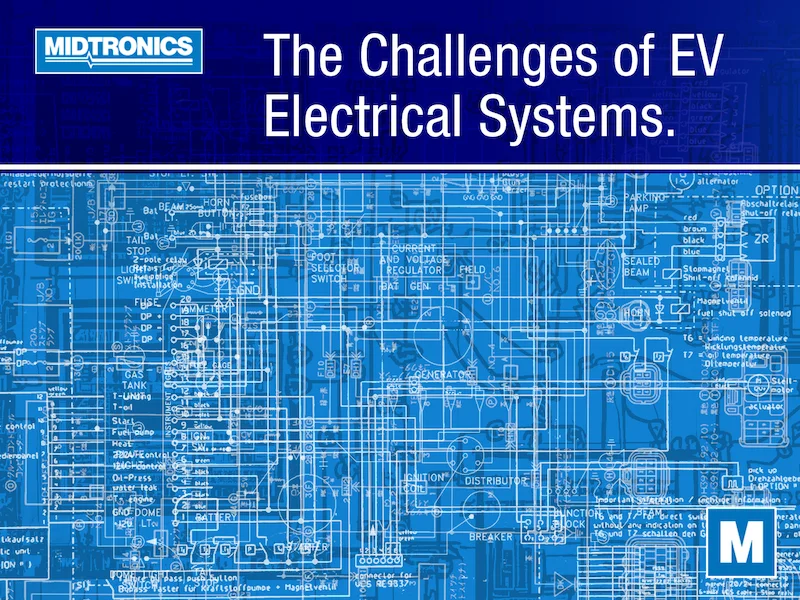Increasingly complex features are nothing new for the automotive industry. Over the past century or so, incredible advancements have seen the development of precision-manufactured vehicles capable of doing much more than anyone imagined, even from a decade or two ago. And with EVs, those advances drive global adoption and take the industry in a different direction at a pace never experienced before, and there’s much to explore and learn.
Whether you’re a technician at a franchised dealership or in an aftermarket service center, the learning curve is massive. Aspects of an EV’s electrical system are prone to being misunderstood, and it can be dangerous to the wrong person. These five challenges for EV electrical systems could be a key to safely and efficiently servicing problems that you encounter coming through the door.
Exposure to Lethal High Voltage
Arguably the most important aspect of servicing an EV is safety with the battery pack. Some vehicle models are being manufactured with more than 200 kWh of battery capacity, and common EV operation can range from 400 to 800 volts, depending on the vehicle. At those figures, a mistake could quite literally cost a person life or limb.
It’s why EV servicing should always be done by a technician certified not just to work on high-voltage systems, but also by someone who’s educated in the specific make and model that needs to be serviced or repaired. For repair shops, staying on the right side of safety recommendations can keep everyone in your shop safe while working on these vehicles that contain immense amounts of energy.
Complex Electrical Design
For ICE vehicles, it’s become commonplace in recent years for a model to contain upwards of 100 control modules. They range from modules necessary for key operations like the engine control module, powertrain control module, transmission control module, and body control module to lesser ones like those used for the HVAC system, electronic suspension, and more.
But EVs also have complex designs, and it could go well beyond the average number of modules that an ICE vehicle has. Systems like regenerative braking, battery management, advanced ADAS features, and V2X technologies all require a module able to perform key functions. It takes an incredible amount of computing power to operate EVs, and that can become a challenge when issues come up.
Technicians need to rely on excellent diagnostic processes provided by the vehicle manufacturer in order to narrow down concerns accurately. And that gets all the more complicated when there’s an intermittent concern.
Miles of Wiring
Like in human relationships, communication is key for a healthy EV. In the common OBDII diagnostic system found in ICE vehicles, it was relatively simple to trace where communication broke down. A broken wire, corrosion in a connector, or a bent or loose pin could often be traced and repaired due to a single symptom. For example, a blower motor that only worked on high could be traced back along a dedicated circuit to find whether there’s a broken wire, a bad blower motor resistor, or a blower motor that’s drawing too much power. But for EVs, OBDII isn’t the protocol used – it’s too cumbersome and slow.
Instead, CAN Bus, or Controller Area Network Bus, forms the nervous system in an EV. A single circuit can now provide two-way communication between controllers along with other critical roles. But that complicates diagnostics, since that same circuit being disrupted by a broken wire or damaged connector could now cause a handful of symptoms.
And while CAN Bus can simplify circuitry and reduce the amount of wiring necessary, there are still miles of wiring between the bumpers. That can create time-consuming headaches for a technician to diagnose, and it leaves the door open for issues like corrosion that tend to progress with age, especially in certain climates and conditions.
Separate HV and 12-Volt Systems
What’s most commonly spoken of with electric vehicles is the high-capacity, high-voltage battery pack. Like gasoline in an ICE vehicle’s tank, it’s the energy reserves that are used to propel the car. Whether you’re a vehicle owner or a mechanic, it’s a typical oversight that not all systems in the car use that powerful HV battery.
A 12-volt battery is standard equipment in every EV. It’s tasked with keeping the safety and interior systems along with lighting in operation. The reasons for it are actually quite simple:
- It could be incredibly dangerous to occupants or safety personnel if non-propulsion systems were powered by the HV battery and there was a problem. For example, a broken wire at the power window switch could electrocute the operator, or the complete vehicle could be energized in the event of a collision.
- It would be cost-prohibitive to re-engineer all of the required electrical parts. Since most parts are already designed and available for the 12-volt systems from manufacturers worldwide, it makes the most sense to continue using them.
- The 12-volt system can continue to power safety systems, even if the HV battery is out of commission.
Still, there’s plenty of opportunity for the roles of each system to be confused, and that can lead to mistakes when servicing these highly technical vehicles.
What Can Be Done When Servicing EVs
First and foremost, EV electrical system repairs should only be performed by qualified individuals. Handling an HV battery can be extremely dangerous and requires knowledge of how it works as well as safety equipment when diagnosing, repairing, or replacing.
Shops that repair EVs or expect to service them in the coming months and years should invest in specialized equipment to make the processes safer. From devices to safely discharge an EV’s HV battery to equipment for balancing battery modules, there are items that are indispensable for a repair shop. They will help you maintain a reputation of safely and professionally servicing electric vehicles.




